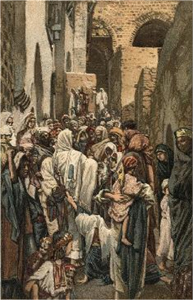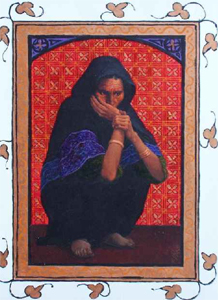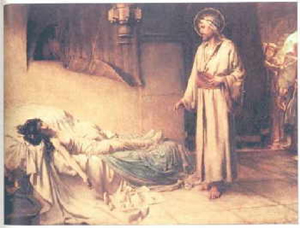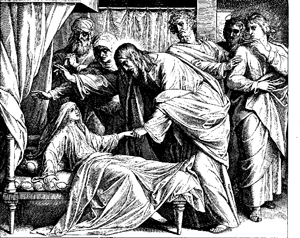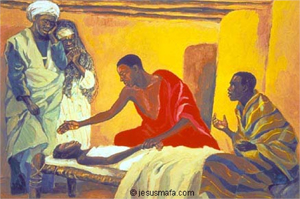
Christmas
Easter
Pentcoest
All Saints
Christ The King
Confirmation
Palm/Passion
Reformation
Stewardship
Books of the Bible
Lenten Series
Christmas Dramas
Videos
Series A - Matthew
Series B - Mark
Series C - Luke
Series D - Other
To contact
Edward F. Markquart
info@sfs.com

Series B PENTECOST 4B Mark 5:21-43 SYNOPSIS OF THE FOUR GOSPELS, Kurt Aland, English Edition, P. 42, 84. This Bible study is from THE LIFE OF CHRIST: A Study in the Four Gospels. This free 54 week course for the laity will be available for congregations beginning in 2006. #95. Jarius' Daughter And The Woman WIth The Hemorrhage Matthew 9:18-26, Mark 5:21-43, Luke 8:40-56 P. 84. Context: This is the third story in a sequence of four stories about healing. This sequence is found in Matthew, Mark and Luke, and all four stories belong together. These stories are: a) the healing of the storm, b) the healing of the demoniac, c) the healing of Jairus’ daughter and d) the healing of the woman who had a hemorrhage for twelve years. Context: Jesus was the Messiah. Overcoming disease and death were signs that the messianic reign of God had finally arrived. It was believed that when the Messiah came, “the blind would receive their sight, the lame would walk, lepers would be cleansed, the deaf would hear, the dead would be raised up, and the poor would have good news preached to them.” (Matthew 11:2-6; Luke 7:18-23). This was a fulfillment of an Old Testament prophecy from Isaiah 29:18 (the deaf shall hear; the blind shall see) and Isaiah 35:5, 8 (eyes of the blind opened, the ears of the deaf unstopped, the lame man shall leap like a rabbit, the tongue of a dumb man shall leap for joy.) The story is told in detail in all three gospels. Each gospel offers a unique perspective. The details from this story are superb and make for colorful storytelling. The numerous details in this story are reminiscent of a previous story about the healing of the storm (Jesus in the stern of the boat with his head on a pillow.) The numerous, innocuous details are an indication of an eye-witness who oberved the event (rather than a fabricator of minutiae in order to give the illusion of historical authenticity.) Simon Peter was part of this story and shared his recollections with John Mark who wrote the Gospel of Mark. - When Jesus had crossed again in the boat to the other side, a great crowd gathered around him; and he was by the sea. Jesus returned from the Decapolis where he had head the demoniac, perhaps returning to the village of Capernaum and to the synagogue in his own hometown. Mark says that “they were beside the sea.” There were not many villages on the shores of the Sea of Galilee. Capernaum was a village on the shores of the Sea of Galilee. -Then one of the leaders of the synagogue named Jairus came and, when he saw him, fell at his feet and begged him repeatedly, Jesus was back in Jewish territory. Mark’s gospel tells us that Jairus was one of the rulers of the synagogue. Jairus was an important person in his community. From Biblical scholars, we learn that Jairus was not a teacher, rabbi or political member of the ruling Sanhedrin, but that he was the presiding leader of the synagogue. That meant, he was responsible for worship services e.g. appointing those who read the Scriptures during worship, prayed during worship, and taught during worship. It also seems that he may have been wealthy or a person of economic means. The synagogue was the most important institution in a local Palestinian village, and Jairus was the presiding officer of that synagogue which meant that Jairus was the leading citizen of his village. But, being the presiding official of the synagogue, did not protect Jairus from the evil vicissitudes of life. Jairus may have been “super-successful” in the eyes of his world, but this did not insulate him from one of the most devastating tragedy he could experience, the death of his only child, a daughter. This man fell as Jesus’ feet and begged him. To fall at someone’s feet and to beg him was a sign that Jairus desperately needed what Jesus had to offer. So often in the miracles of Jesus, we see people who were in desperate situations, pleading with Jesus for help. At this point in Jesus’ life, the leaders of the synagogues were not deeply hostile to Jesus. Rather than being hostile to Jesus, this man was desperate for the healing power that lived in Jesus. -"My little daughter is at the point of death.” “My little daughter, my only daughter, my twelve-year old daughter.” We know how precious all of our children are to us, but when a child is your only child, the potential loss of that child becomes increasingly painful and poignant. Mark tells us the daughter was Jairus’ little daughter; Luke informs us that this was his only daughter and that she was twelve years old and was dying. What tragedy. In Jewish society of that era, a twelve year old girl was on the edge of becoming a young woman who was soon to be married. But Jairus’ little girl was not maturing into her young future but her life was going to be snuffed out prematurely. As human beings, we can imagine Jairus’ inner fear, pain and consuming sadness. -“Come and lay your hands on her, so that she may be made well, and live." The ruler of the synagogue deeply believed that Jesus could heal his little girl. Jairus was on his knees and begging for Jesus to help her, to heal her. Once again, as we have in previous stories, we encounter great faith. We remember the centurion’s slave/or son who was deeply sick and we remember the deep faith of the centurion that Jesus could heal his slave. This story is another “great faith” story. -So he went with him. And a large crowd followed him and pressed in on him. As in the other stories about Jesus, the presence of a large crowd of people was an indication that they wanted a specular miracle, that they wanted to see a great show by the "Houdini of the Holy Land." The great crowd is never an indication of having true faith and great faith but of people who want to see a miracle. -Now there was a woman who had been suffering from hemorrhages for twelve years. In the middle of the story of Jairus and his dying daughter, we encounter another story. Here was a woman who had been hemorrhaging for twelve years. According to Jewish law (Leviticus 15:25-27), she was declared to be unclean. That means, she was to be cut off from attending the synagogue service of worship and also cut off from her friendship patterns. She was to be ostracized from being part of Jewish society. We also learn from Biblical historians that the Jewish Talmud describes eleven different cures for this common disease. We can imagine the devastation of being declared unclean for twelve years. That means, she had been living in isolation for a long, long time. -She had endured much under many physicians, and had spent all that she had; and she was no better, but rather grew worse. Many people today have similar experiences. That is, many people visit a great variety of doctors, trying to find a cure. Many people today spend much of their money on doctors and become medically poor. Many people today do not get better but worse. In ancient days with ancient medicine, we cannot even begin to imagine the primitiveness of medical treatment and its consuming costs. This woman had spent all of her earnings on medicine and was worse for it. -She had heard about Jesus, was no better but rather grew worse. Yes, this woman had spent all her money on doctors and medicines but her condition had not improved one iota but was worse. -She had heard about Jesus. There are times in life when we hear about Jesus and what Christ can do for us. This woman had heard reports that the power of God in Jesus could heal her. You and I also need to spread reports to our family, friends and communities about how Jesus has healed us in our situations. When other people may hear those reports, they may come to Christ, the Presence of God, and Christ may heal their lives as well. -And came up behind him in the crowd and touched his cloak, for she said, "If I but touch his clothes, I will be made well." This woman’s faith was almost superstitious. That is, if she touched his hankie, his garment, the fringe of his garment, his hand, she would be healed. Her faith seems to have been a superstitious faith but that didn’t’ stop Jesus from healing her. Very often, our faith does not measure up to the church’s definition of a high quality of faith. This woman’s faith was not complex, theologically sophisticated, or religiously stylish. Rather this woman’s faith was simple and seemingly superstitious, and that was OK with Jesus. Focus on the word, “fringe.” This word can also be translated, “tassel,” and in Jesus’ day, there were four tassels at the bottom of the outer garment. Today, those tassels can still be seen on Jewish prayer shawls. -Immediately her hemorrhage stopped; and she felt in her body that she was healed of her disease. Jesus healed her immediately. -Immediately aware that power had gone forth from him, In spite of the crushing mob of humanity around Jesus, pushing and pulling and touching him, Jesus knew that this woman had touched the hem of his garment and the power of God had gone out from him to heal this woman. Jesus was filled with the power of God, the power of the Holy Spirit, the power of the healing and compassion, and this power went out from Jesus. We also hear in Acts 1:8 that this power will be given to us as Christians, that we too have the power of God inside of us. No, not a power that is the same as the power in Jesus, but a power similar to Jesus. Within us, there is a power to heal, a power to love, a power to help cure the ills of the world. Also, many of us feel the same way towards other enormously gifted peple e.g. wanting to touch Mother Theresa’s hand or shake hands with Nelson Mandella or talk with Abraham Lincoln or a host of other famous and gifted people. It is our desire that the special qualities in those people would rub off on us. In the painting below, Look carefully for the woman in the lower center of the painting. Her head is covered with a white cloth. Her right hand is reaching out to touch the fridge of Jesus’ garment. Her left hand is on the ground and stabilizing her. Her right leg is stretched out to the lower right hand corner of the painting. She is lost in the crowd. The artist captures the dramatic tension of the event.
-Jesus turned about in the crowd and said, "Who touched my clothes?" William Barclay, in his commentary on the book of Matthew, is at his best when he writes: “When she touched it, it was as if time stood still. It is as if we were looking at a motion picture, a film, and suddenly the picture stopped and left us looking at one scene. The extraordinary and movingly beautiful thing about this scene is that suddenly in the midst of the crowd, Jesus stopped, and for the moment, it seemed that for him that no one but the woman and her need existed.” “For Jesus, no one ever is ever lost in the crowd.” And God is like that. Barclay goes on to tell a story about the sinking of the unsinkable ship, Titanic, in April of 1912. “The next day, the headline of a famous newspaper was devoted entirely and exclusively to the death of the multimillionaire, John Jacob Astor. At the end of the article, the newspaper almost casually mentioned the other 1800 people who died. The other 1800 were not that important. Such is the attitude of the world and many public media, but not God, the Father of our Lord Jesus Christ. The Lord is concerned about every single person and no person is lost in the crowd, however unimportant that person may be in the eyes of the world.” -And his disciples said to him, "You see the crowd pressing in on you; how can you say, "Who touched me?' " He looked all around to see who had done it. -But the woman, knowing what had happened to her, came in fear and trembling, fell down before him, and told him the whole truth. We can see this woman. Simon Peter was at his best as he was retelling this story. The woman approached Jesus, shaking with fear and fell down before him and told it all. She told him the whole truth about what she had done. That is what God wants from us. God wants to tell God the whole truth about ourselves and our need for healing. Like Jairus with his dead daughter and the centurion with his sick slave/son, this woman too was desperate and she needed the healing of Jesus. So we see three unique kinds of people and three unique shapes of faith: a Roman centurion, a presiding officer of the synagogue, and a sick woman who was the poorest of the poor of her society. Three stories. Three people. Three different shapes of faith. But all believing that Jesus could bring healing to their lives. -He said to her, "Daughter, your faith has made you well; go in peace, and be healed of your disease." As with the other stories, we are again encounter the power of faith in Jesus and how that power of faith is part of a cure. A question almost always rises: “How about people who have deep faith in Jesus and his healing power and those people were not healed? How do you explain that?” We have dealt with this question many times in our lives, and we deal with it especially during those times when our family member or friend is sick and they are not being healed physically. Or, maybe that person is yourself or myself who is not being healed. We often ask: “What is wrong with my faith? How come I am not being healed? How come my loved one is not being healed? Do I not believe enough? Do they not believe enough?” As human beings, we are forever asking those questions, even when we are older and supposedly more mature. It is a condition of our humanity to ask such questions because all human beings ask them at sometime or another. And we all know the answer. That is, not every one is emotionally or physically healed, regardless of the depth and sincerity of our faith and our prayers. Life does not work that way. Nor did it work that way in Jesus’ day either. When a person is not healed physically, we ask other prayers e.g. “God, give that person (or myself) the strength and wisdom we need for living with this infirmity. Help us to handle this awful situation. Please God, we need your strength and wisdom to face what life is giving to us. Please God, we need your strength, presence, and wisdom to die peacefully.” -While he was still speaking, some people came from the leader's house to say, "Your daughter is dead. Why trouble the teacher any further?" Now, we are back to the original story. We have finished the story within a story, and now we are back to the first plot. Jairus’ daughter. She is dead. Do not bother Jesus anymore because Jairus’ only daughter has died. -But overhearing what they said, Jesus said to the leader of the synagogue, "Do not fear, only believe." We can imagine Jairus’ fear, for fear is our primary human emotion when we hear the bad news of cancer or the bad news of death. Our hearts explode with fear, panic and being stunned. So it was for Jairus. Yet Jesus said “not to fear but only to believe.” Once again, we hear Jesus inviting us to “only believe.” To only believe in God, to only believe that there is life after death, to only believe that God is with us in every circumstance, to only believe. Yes, we as human beings want to “only believe” but our reason and instincts seem to feed the doubts in our minds. We know if we “only believed,” life would be better/healthier for us. -He allowed no one to follow him except Peter, James, and John, the brother of James. This is the first time in the Jesus Story that we hear about Peter, James and John as being the select, inner group of Jesus’ disciples. Peter was telling the story to John Mark and Peter names himself at the top of the list. There are several times in the gospel stories that we hear about the “big three” disciples, the important three, the three that seem to have a special position among the twelve disciples. Peter, James and John are at the Mount of Transfiguration, the Garden of Gethsemane, and here in the privacy of Jairus’ home to see the raising of Jairus’ daughter from the dead. -When they came to the house of the leader of the synagogue, he saw a commotion, people weeping and wailing loudly. Flute players were common at ancient ceremonies of grief for both the Jew and the Romans. The wailing music off the flute was associated with death, and Roman law limited the number of flute players at a funeral to ten. In that ancient Jewish culture, there were “professional” wailers and weepers, those people whose position in society was to weep and mourn at funerals. The wailers and weepers were already there, raising a tumultuous fuss. -When he had entered, he said to them, "Why do you make a commotion and weep? The child is not dead but sleeping." When someone dies, we occasionally say that they are sleeping or that they have “passed away’ or “slept away.” The British scholar, Barclay, says that there is a Greek word that describes death as sleeping, but that Greek word was not used here in this context. Rather, the Greek word for sleeping in this text means just that: “the young girl was sleeping.” Barclay also says that deep/deathly comas were common at this time in history; that burials occurred quickly in the hot Palestinian climate so that the body did not deteriorate; and that people were not infrequently buried alive when they were in a deep coma. For Barclay, this story is an example of “divine diagnosis” as much as it is an example of “divine healing.” Jesus diagnosed the young girl that she was in a deep sleep of a coma, and Jesus raised her from that coma and saved her from being buried alive. This story is an example of Jesus delivering a person from death. Respecting Barclay’s analysis, it seems that the people of Jesus’ day would simply have declared that Jesus raised this young girl from the dead. -And they laughed at him. Circle, underline, highlight. Yes, there are still people who laugh at Jesus. But I don’t think many. That is, the crowds may laugh at us Christians and the imperfections and sinfulness of our lives, but I sense that people “out there” do not laugh at Jesus. In our western world, Jesus has become a majestic symbol of goodness, spirituality, love and justice, even if people don’t believe in him as the Son of God. -Then he put them all outside, and took the child's father and mother and those who were with him, and went in where the child was. Only the mother, father, and the three disciples were with him in the room where the child was. Jesus was not going to “show off” his healing powers for the crowd who wanted a “Houdini healer from the Holy Land” to put on a magic show. -He took her by the hand and said to her, "Talitha cum," which means, "Little girl, get up!" “Tabitha cumi” is an Aramaic expression for “maid” or “little girl.” We find that Jesus also spoke an Aramaic phrase from the cross, “My God, My God, why have you forsaken me.” Peter would have been the source of this Markan story. We do not know why Matthew and Luke do not include this Aramaic phrase in their version of the event. -And immediately the girl got up and began to walk about (she was twelve years of age). The miracle occurred. The daughter was raised from her coma like sleep, from her death. -At this they were overcome with amazement. When you experience a miracle in your life, you normally are amazed at the marvelous gift that God has given to you. We are all amazed when we hear stories of God delivering people from the jaws of death. -He strictly ordered them that no one should know this, and told them to give her something to eat. Persistently, we have heard Jesus try to keep the news of his healing power quiet. Jesus knew that the crowds would follow him for the wrong reason, and soon we will hear about thousands of people clamoring around Jesus for healing, food and other miracles. PAINTING AND IMAGINATION:
|
|
